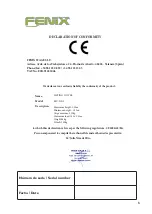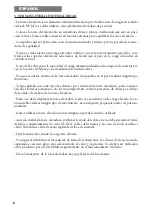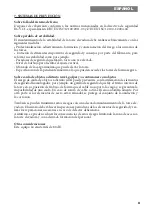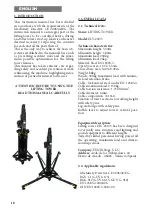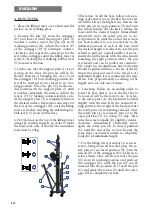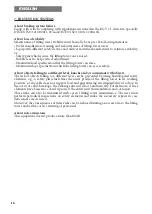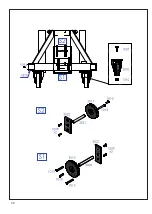
14
14
ENGLISH
4. HOW TO USE
1. Place the lifting tower over a firm and flat
surface on its working place.
2. Remove the pin (Q) from the outrigger
(H) and lower it until the support plate (J)
touches a surface, insert the pin (Q) in its
working position (R). Adjust the tensor (P)
of the outrigger (H) by turning it counter-
clockwise, and repeat the same steps for the
rest of the outriggers until the lifting tower is
leveled, checking the stabilizing bubble level
(Y) located at the base.
3. In the case that the support plate (J) is not
resting on the floor, the process will be di-
fferent. Instead of bringing the case (C) of
the outrigger (H) to its working position (R),
it will be inserted in the closest to its wor-
king position. Place the pin (Q) in the nee-
ded position, tilt the support plate (J) until
it touches completely the surface. Adjust the
tensor (P) by turning counterclockwise un-
til the support plate (J) is completely firm on
the desired surface. Repeat the same steps for
the rest of the outriggers (H), until the lifting
tower is leveled, checking the stabilizing bu-
bble level (Y) located at the base.
4. Put the load on the top of the lifting tower
using the suitable support, in order to make
the load work only vertically. The minimum
load must be 25kg.
5 Elevation: To lift the bars, follow a descen-
ding order, that is to say, the first bar to be lif-
ted will be always the highest one. Release the
safety pin (A) in open position (T) and turn
the winch handle (B) clockwise, lifting the
load until the desired height. Immediately
afterwards, move the safety pin (A) to clo-
sed position (S), until the end of the section
has been reached. Go on successively to the
different positions of each of the bars, until
the desired height is reached. In case the pin
is hard to pull out, a small number of move-
ments should be made with the winch until
founding the right position where the pin
is released and can be pulled out comforta-
bly. Under no circumstances any of the pins
should be pulled with force. In case of the lif-
ting tower does not need to be raised to its
maximum height, it is recommended to raise
all the bars proportionally according to the
height, and not only one of them.
6. Lowering: Follow an ascending order to
lower the bars, that is to say, the first bar to
be lowered will be the lowest one. To relea-
se the safety pins (A), the load must be lifted
slightly with the winch. In the normal wor-
king position, the weight of the load prevents
the safety pins (A) from being released. Once
the safety pin (A) is released, move it to the
open position (T), by doing (U) step. Then
turn the winch handle (B) slightly counter-
clockwise. Immediately afterwards, move
again the safety pin (A) to closed position
(S), until the end of the section. Repeat the
same steps successively until it is completely
folded to its minimum height.
7. For the lifting tower transport, it is neces-
sary to bring down all bars and place the sa-
fety pins (A) in closed position (S). Turn the
tensors (P) of the outriggers (H) clockwise to
release them. Once released, remove the pin
(Q) from its working position and push up
the outrigger (H), until the pin (Q) can be
inserted into the position (D). Insert the pin
(Q) and adjust the tensor (P) until the outri-
gger (H) is completely vertical.
S
T
U
P
C
D
Y
J
B
R
A
H
Q
Содержание ELV-230/5
Страница 2: ...2 2 FENIX STAGE S L U Avda de los Trabajadores 24 Horno de Alcedo 46026 Valencia Spain...
Страница 17: ...17...
Страница 18: ...18...
Страница 19: ...19...
Страница 20: ...20...
Страница 21: ...21 NOTAS NOTES LIFTING TOWERS...
Страница 22: ...22 NOTAS NOTES LIFTING TOWERS...
Страница 23: ...23 NOTAS NOTES LIFTING TOWERS...



